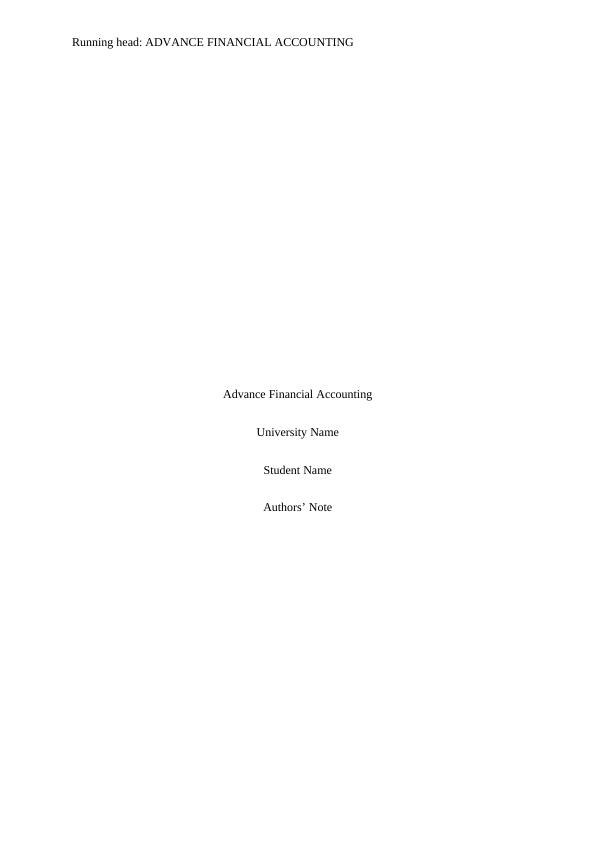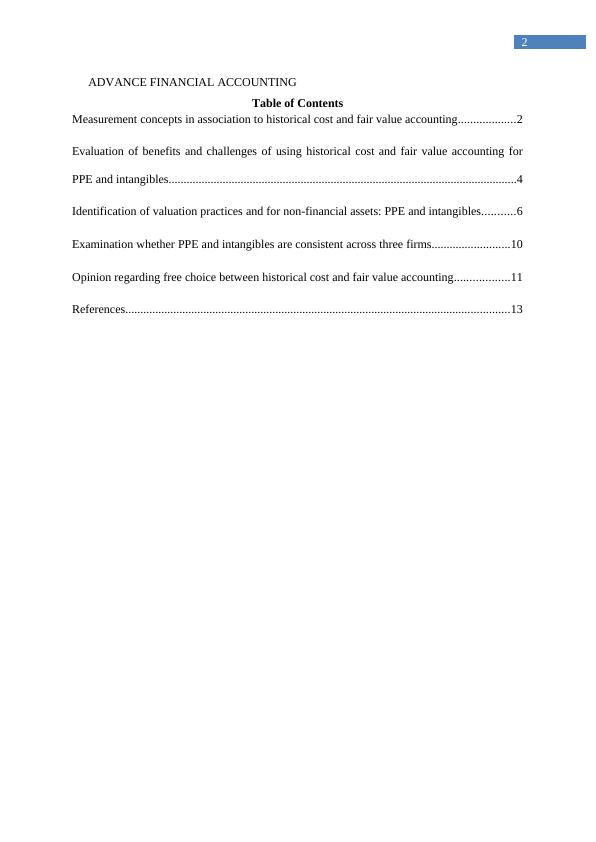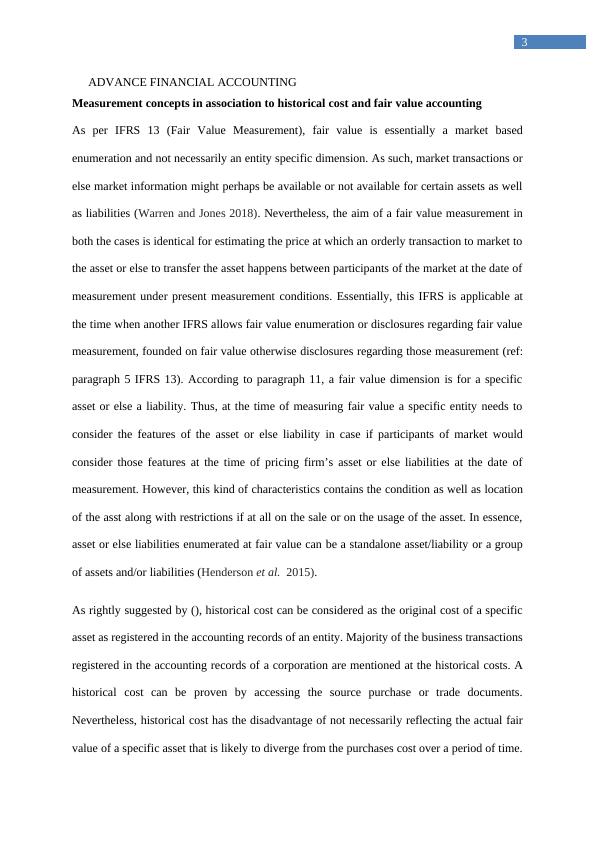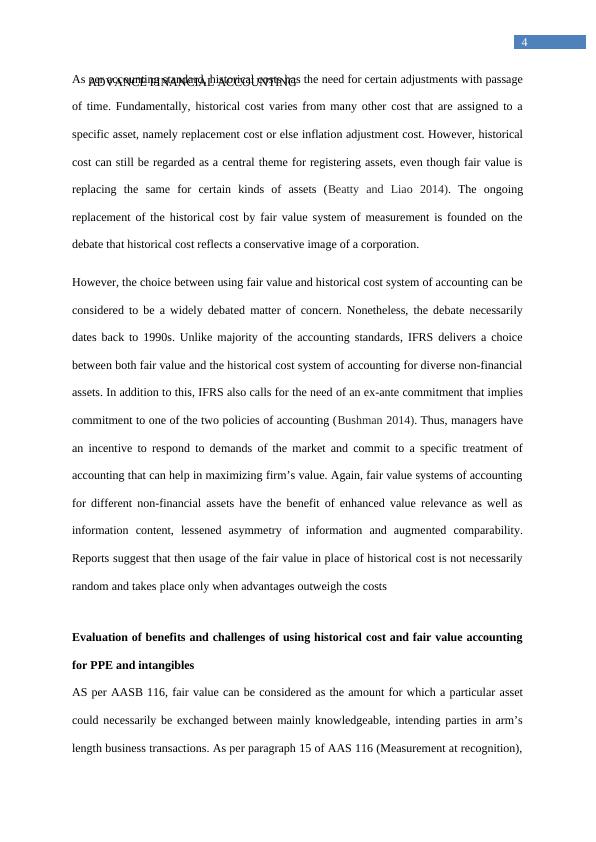Advance Financial Accounting: Doc
Added on 2020-05-16
15 Pages4124 Words34 Views
Running head: ADVANCE FINANCIAL ACCOUNTINGAdvance Financial AccountingUniversity NameStudent NameAuthors’ Note

2ADVANCE FINANCIAL ACCOUNTINGTable of ContentsMeasurement concepts in association to historical cost and fair value accounting...................2Evaluation of benefits and challenges of using historical cost and fair value accounting forPPE and intangibles....................................................................................................................4Identification of valuation practices and for non-financial assets: PPE and intangibles...........6Examination whether PPE and intangibles are consistent across three firms..........................10Opinion regarding free choice between historical cost and fair value accounting..................11References................................................................................................................................13

3ADVANCE FINANCIAL ACCOUNTINGMeasurement concepts in association to historical cost and fair value accountingAs per IFRS 13 (Fair Value Measurement), fair value is essentially a market basedenumeration and not necessarily an entity specific dimension. As such, market transactions orelse market information might perhaps be available or not available for certain assets as wellas liabilities (Warren and Jones 2018). Nevertheless, the aim of a fair value measurement inboth the cases is identical for estimating the price at which an orderly transaction to market tothe asset or else to transfer the asset happens between participants of the market at the date ofmeasurement under present measurement conditions. Essentially, this IFRS is applicable atthe time when another IFRS allows fair value enumeration or disclosures regarding fair valuemeasurement, founded on fair value otherwise disclosures regarding those measurement (ref:paragraph 5 IFRS 13). According to paragraph 11, a fair value dimension is for a specificasset or else a liability. Thus, at the time of measuring fair value a specific entity needs toconsider the features of the asset or else liability in case if participants of market wouldconsider those features at the time of pricing firm’s asset or else liabilities at the date ofmeasurement. However, this kind of characteristics contains the condition as well as locationof the asst along with restrictions if at all on the sale or on the usage of the asset. In essence,asset or else liabilities enumerated at fair value can be a standalone asset/liability or a groupof assets and/or liabilities (Henderson et al. 2015). As rightly suggested by (), historical cost can be considered as the original cost of a specificasset as registered in the accounting records of an entity. Majority of the business transactionsregistered in the accounting records of a corporation are mentioned at the historical costs. Ahistorical cost can be proven by accessing the source purchase or trade documents.Nevertheless, historical cost has the disadvantage of not necessarily reflecting the actual fairvalue of a specific asset that is likely to diverge from the purchases cost over a period of time.

4ADVANCE FINANCIAL ACCOUNTINGAs per accounting standard, historical costs has the need for certain adjustments with passageof time. Fundamentally, historical cost varies from many other cost that are assigned to aspecific asset, namely replacement cost or else inflation adjustment cost. However, historicalcost can still be regarded as a central theme for registering assets, even though fair value isreplacing the same for certain kinds of assets (Beatty and Liao 2014). The ongoingreplacement of the historical cost by fair value system of measurement is founded on thedebate that historical cost reflects a conservative image of a corporation. However, the choice between using fair value and historical cost system of accounting can beconsidered to be a widely debated matter of concern. Nonetheless, the debate necessarilydates back to 1990s. Unlike majority of the accounting standards, IFRS delivers a choicebetween both fair value and the historical cost system of accounting for diverse non-financialassets. In addition to this, IFRS also calls for the need of an ex-ante commitment that impliescommitment to one of the two policies of accounting (Bushman 2014). Thus, managers havean incentive to respond to demands of the market and commit to a specific treatment ofaccounting that can help in maximizing firm’s value. Again, fair value systems of accountingfor different non-financial assets have the benefit of enhanced value relevance as well asinformation content, lessened asymmetry of information and augmented comparability.Reports suggest that then usage of the fair value in place of historical cost is not necessarilyrandom and takes place only when advantages outweigh the costsEvaluation of benefits and challenges of using historical cost and fair value accountingfor PPE and intangibles AS per AASB 116, fair value can be considered as the amount for which a particular assetcould necessarily be exchanged between mainly knowledgeable, intending parties in arm’slength business transactions. As per paragraph 15 of AAS 116 (Measurement at recognition),

End of preview
Want to access all the pages? Upload your documents or become a member.
Related Documents
ACCT19061 Advanced Financial Accounting (AFA)lg...
|16
|4308
|76
Advance Financial Accounting PDFlg...
|17
|4804
|48
Advance Financial Accounting Reportlg...
|10
|2715
|43
Advance Financial Accounting Assignment | IASB Frameworklg...
|16
|4547
|48
Assignment Accounting | Historical Cost Vs Fair Value Accountinglg...
|17
|3947
|42
Accounting Theory - Assignmentlg...
|5
|883
|99
